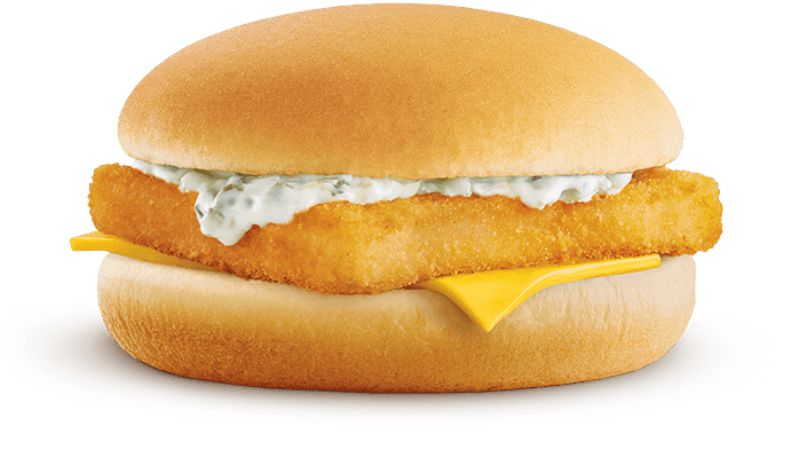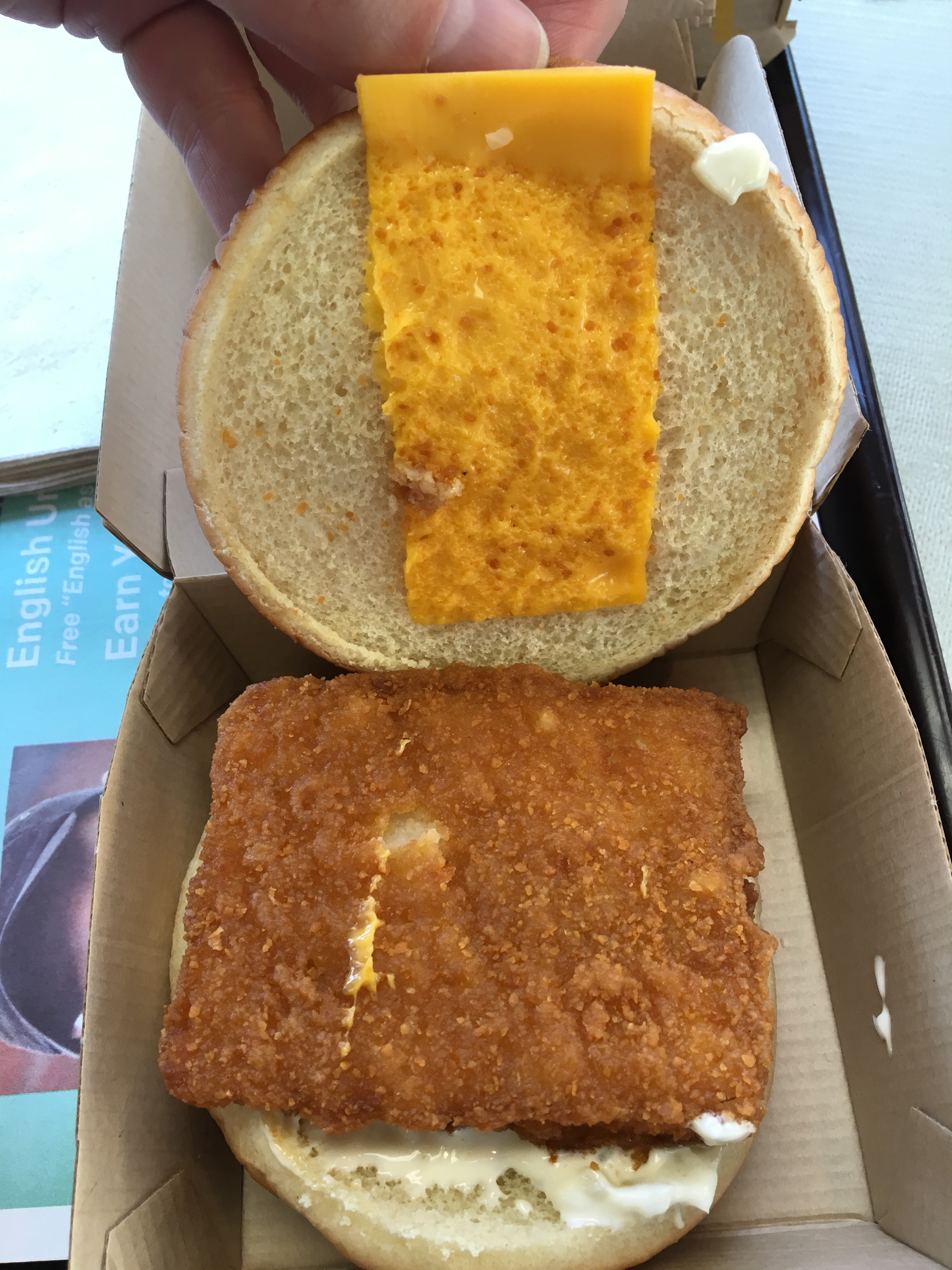I Quit All Meats And Fast Food—except For The Filet-O-Fish
I haven't eaten fast food for going on a decade now. I'm not a snob about it—or at least I try not to be—but 90 percent of the menu items hold no interest for me. In part, this is because I'm also a vegetarian. Well, pescatarian (no red meat, no chicken, just seafood), but that's a stupid word I refuse to use, and in most situations in America the difference is negligible. Most of the places we consider to be fast food are centered around beef and chicken, with fattier parts of pork thrown in, so veggies are at a distinct disadvantage. The rest of it is a combination of trying to be healthy and generally preferring food made out of... well, actual food.
But the McDonald's Filet-O-Fish. It shatters my senses and scrambles my internal desires. There is no mental blockade against garbage food it can't punch through, the Jean-Claude Van Damme to my every other kickboxer ever. Once a year, my good intentions fail me, and I descend upon McDonald's and luxuriate in the gluttony of consuming it. We FiletHeads (not FishHeads, for the obvious reason of not wanting to befuddle jam band aficionados) know the perfect fast food item doesn't involve ground beef, or french fries, or any sides or pork or any of that nonsense. No, it's the world's plainest fish sandwich, inexplicably devoid of anything that, on its own, could be identified as a good ingredient.
For people who eat burgers from McDonald's regularly, seeing a fish option is a crafty means of suggesting it could be the "diet" choice, if one chooses to ignore the nutrition menus and/or a general understanding of fried food. A quick perusal of the nutritional values confirms the suspicion that, compared to a burger, the Filet-O-Fish is only a healthy choice in the way that eating a box of Buncha Crunch is healthier than dumping that Buncha Crunch into a tub of buttered popcorn.
What's fascinating about the Filet-O-Fish is that, for a significant percentage of the American population, it's likely their first encounter with seafood. It was certainly mine. Growing up in the landlocked middle of the country was one reason. Also: Kids hate fish, unless it comes in stick form. Any seafood not resembling a four-sided shape and young people are slow to board the train. There's no cries of "Papa, more fennel-roasted arctic char, please!" echoing from the mouths of the nation's 6-year-olds.
No, the Filet-O-Fish is the gateway drug that turns people on to the wider world of seafood. Which is ironic, because delicious as it may be, there's almost no fish-based meal that tastes less like fish. Even with McDonald's proudly touting its 2013 decision to use only Marine Stewardship Council certified wild Alaskan pollock, it's a bit of marketing fluff—pollock is one of the cheapest whitefishes available, with a flavor so neutral and adaptable it's the main ingredient in many imitation crab sticks.
I decided to use this year's annual descent into my primal consumptive bacchanalia as a means of sussing out what makes the Filet-O-Fish such a perfect food item. I would head to my neighborhood McDonald's, and slowly and methodically eat four Filet-O-Fish sandwiches, focusing my attention each time on one of the four ingredients that make up this marvel of Ray Kroc's legacy. (To be fair, the sandwich was actually invented in 1962 by Lou Groen, a Cincinnati franchisee who noticed he was losing all his Catholic customers on Fridays, and decided to do something about it.) It would be a simple matter, I figured. I would break down, in a meticulous manner, each of the following items, which are the only things that make up the Filet-O-Fish:
- The bun
- The cheese
- The tartar sauce
- The (non-proper noun) filet-o-fish
From such small beginnings are colossi born.
Filet-O-Fish #1: The bun
The bun is like sponge. A little, mushy, steamed sponge. Individually, it's the smooshiest bread imaginable, like a bun made from Ethiopian injera. By itself, it would be like eating soggy challah. What's unusual is that compared to other higher-grade sandwiches on McDonald's menu (of the non-plain hamburger variety), the Filet-O-Fish receives the barest-bone bun treatment. Most other burgers, chicken sandwiches, and the McRib offer some improvement from its base-level bread: What McDonald's calls its artisan roll, or toasted for its McChicken, or sesame-seed-flecked for the flagship Big Mac. Not the Filet-O-Fish. It's the plainest possible bun, spared even the attempt at toasting to bring out some flavor. It's just bread, full stop, functioning solely as discreet receptacle for the foodstuffs inside.
Filet-O-Fish #2: The cheese
How had I never before noticed how small this limp slice of cheese was? It's maybe half the width of the filet, like a yellow loincloth covering the fish's midsection. I intentionally try a bite of only bun and cheese (with a tiny lick of tartar), and it's a sad amuse bouche, with the cheese barely existing on its own. I pull off a small hunk and give it a nibble. It tastes a little like American cheese (which it technically is), and a lot like a slightly savory, squishy gel. It's innocuous and bland.
And yet, the cheese delivers something essential. It's hard to even acknowledge the dairy's presence, let alone understand what it's doing here; what prompted old Mr. Groen to add a thin strip of cheese to a piece of fish in the first place? Unfortunately, Lou Groen died in 2011 at the age of super-old, so he carried that secret to his grave. But here's my best guess: The cheese provides a layer of slick softness between the softness of the bread and the crisp of the filet. It's not a binding agent, but rather a separating agent, creating a thin membranous filter between the other two, and injecting it with a hint of savory flavor. Turns out, Lou knew what he was doing—the ingredient is barely present on any individual level, but you notice when it's not there.
I resolve to take a 10-minute break before the next sandwich. I make it maybe seven minutes.
Filet-O-Fish #3: The tartar sauce
I open the cardboard lid and am greeted by a sandwich in which half the sauce has missed its target. Obviously, extra care was taken with this particular Filet-O-Fish. But this is for research: I scrape the condiment off the the carton and re-apply it as best I can to the sandwich.
The tartar sauce is phenomenal. It's the one component that stands on its own. Whereas normal tartar can be potent and eventually overbearing if slathered on too thick, McDonald's is watered-down enough to sustain ongoing affinity—your taste buds want more, not less. It's not too pickle-y and not too much like mayo. It's the Goldilocks of sauces, just right, and delectably creamy. And yet, it only plays a small role in the overall taste. A full bite registers its existence, but not very much of its flavor.
I am stuffed. Stopping now would be a wise idea. But no, for here comes the pièce de résistance.
Filet-O-Fish #4: The filet
The fish may be certified Alaskan pollock—it may even be surprisingly flaky, especially when compared to the Filets-O-Fish of yesteryear—but it evokes the idea of fish more than it actually resembles one in flavor. It tastes a little like Gorton's fish sticks, another breaded food that manages to drain all the fish-ness from its fish-based product. Mostly, it's just like having a weird protein that doesn't taste much like anything. It's a crispy battered outside, which is then immediately softened by the bite, releasing the moisture from the protein inside, softening the crunch even as you sink your teeth into it. It's the kind of thing that, by itself, is not too different from any other fried food—harder outside, juicy inside, and largely meant to function as a ladle for your condiment of choice.
This last one, unsurprisingly, takes a little longer to polish off than the previous three. But focusing on each ingredient individually has revealed the essential tastelessness of each one, the glory of the tartar sauce notwithstanding—and as has been established, the other items negate much of its impact in the final product.
And that's the Filet-O-Fish magic: Much like The Black Eyed Peas, it takes four bland, largely unappealing components, and fuses them together, elevating it into something you're not proud of loving, but is inexplicably addictive. Cheese is not good on fish, but it works here. The bun is a sad steamed thing, but makes for an effective glove. The tartar sauce provides a gentle kick, a flavor with enough strength and viscosity to be spread out among the dross so it enlivens without giving an overpowering, or even strong, taste bud activation. And then that fish—exploding moisture when you bite, but providing crispiness to offset the fall-apart protein inside. Recipes by definition are about creating something greater than the sum of their parts; this one delivers a level of transubstantiation that's near-religious in its defiance of logic, a fast food water into wine.




